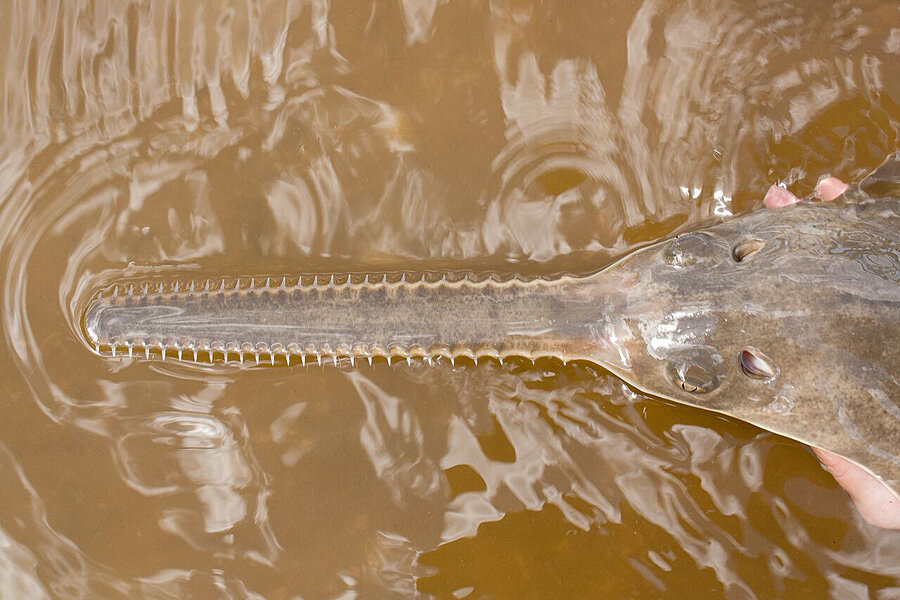Critically endangered fish has offspring without mating
Loading...
A research team combing through genomes of the endangered smalltooth sawfish they had collected in Florida has stumbled across a surprising finding: in a few cases, sawfish had offspring that weren't the result of mating.
Until now, parthenogenesis, the ability of animals that normally reproduce sexually to do so asexually, has previously been observed in certain species of birds, reptiles, and sharks in captivity, but never in the wild.
Andrew Fields of Stony Brook University and his three colleagues weren't looking for parthenogens in the population of sawfish they found in a Florida estuary. Instead, they were studying genetic variation in the critically endangered species. But when they calculated the relatedness of the parents of the 190 individual fish they had sampled, they found that seven fish were found to have "parents" that were genetically identical, that is, they were the very same fish.
“This is the first time that we’ve seen it in a live parthenogenetic species free-living in the wild,” said Mr. Fields, a doctoral candidate in Stony Brook's School of Marine and Atmospheric Sciences.
The sawfish parthenogens “seemed to be normal sawfish” says Fields, and were unidentifiable as parthenogens until their DNA was sequenced and compared against each others’.
Smalltooth sawfish used to be commonly found across the Atlantic, but their species has dwindled to as low as one percent of what it was in 1900, leading the species to be classified as “endangered” on the US Endangered Species List.
Decimation of the smalltooth sawfish population has been a result of commercial fishing practices and habitat modification, although the species is no longer commercially fished because its rarity makes fishing economically unsound. The International Union for the Conservation of Nature notes that the ‘critically endangered’ species is still incidentally caught by commercial fisheries, thus further depleting the species with an estimated population size of 270-504 in the US.
While just three percent of the genomes sampled showed signs of parthenogenesis, this number is much higher than initially suspected, particularly for a vertebrate.
“It could be pretty significant if this is common or if this is triggered. Sawfish do need more conservation. This might be another signal to say ‘hey pay attention right now,’” says Fields.
Parthenogenesis has also been observed in other vertebrates. Sharks, Komodo dragons, chickens, turkeys, and snakes.
In 2012, professor of molecular ecology at the University of Tulsa Warren Booth and his research team found two pregnant pit vipers. “We actually took the females that were pregnant out of the wild and into the laboratory,” says Booth. There his team was able to determine that the offspring of the pit vipers were parthenogens.
The effect of parthenogenesis on gene variation is “actually very bad…essentially [it] creates an individual that is highly inbred across its genome,” says Booth. “Essentially you are eliminating all variation across the genome so it’s a very deleterious, a very bad thing to occur.”
“Is this a sign that they are becoming more depleted than we think and are on the verge of extinction?” asks Field.
But the potential for research has vastly expanded. “It’s a pretty fascinating field of study and it’s a field that has only really erupted in the last five years,” says Dr. Booth. “We don’t really understand what drives parthenogenesis. I think there are some other issues driving it but we are yet to truly understand what they are.”
There remains a need “to do a little more investigating to see how common facultative parthenogenesis is in the wild,” says Field. “I think this study shows that it’s occurring in the natural populations, and the parthenogens are surviving,” says Dr. Booth. “I think it’s much more common than we think it is.”
“We now have the ability to do these large scale genetic studies of populations that will provide a lot more information that we previously achieved,” says Booth.
The research team is encouraging other researchers to scan their microsatellite databases to see if they have unknowingly documented instances of parthenogenesis as well.








